Figure 22-8c is identical to Fig. 22-8a except that particle 3 now lies on the x axis between particles 1 and 2. Particle 3 has charge and is at a distance R from particle 1. What is the net electrostatic force on particle 1 due to particles 2 and 3?
KEY IDEA
The presence of particle 3 does not alter the electrostatic force on particle 1 from particle 2. Thus, force still acts on particle 1. Similarly, the force that acts on particle 1 due to particle 3 is not affected by the presence of particle 2. Because particles 1 and 3 have charge of opposite signs, particle 1 is attracted to particle 3. Thus, force is directed toward particle 3, as indicated in the free-body diagram of Fig. 22-8d.
Three particles : To find the magnitude of , we can rewrite Eq. 22-4 as
.
We can also write in unit-vector notation:
.
The net force on particle 1 is the vector sum of , and , that is, from Eq. 22-7, we can write the net force on particle 1 in unit-vector notation as
. (Answer)
Thus, has the following magnitude and direction (relative to the positive direction of the x axis):
. (Answer)
Topper's Solved these Questions
- ELECTRIC CHARGES AND FIELDSBOOK - RESNICK AND HALLIDAYCHAPTER - ELECTRIC CHARGES AND FIELDSEXERCISE - Check points
9 Videos
- ELECTRIC CHARGES AND FIELDSBOOK - RESNICK AND HALLIDAYCHAPTER - ELECTRIC CHARGES AND FIELDSEXERCISE - Problems
63 Videos
- ELASTICITYBOOK - RESNICK AND HALLIDAYCHAPTER - ELASTICITYEXERCISE - PRACTICE QUESTIONS (Integer Type)
3 Videos
- ELECTRIC POTENTIALBOOK - RESNICK AND HALLIDAYCHAPTER - ELECTRIC POTENTIALEXERCISE - (PRACTICE QUESTIONS) Integer Type
1 Videos
Similar Questions
Figure 22-8e is identical to Fig 22-8a except that particle 4 is now included. It has charge q4=−3.20×10−19C, is at a distance 34 R from particle 1, and lies on a line that makes an angle θ=60∘ with the x axis. What is the net electrostatic electrostatic electrostatic force →F1, net on particle 1 due to particle 2 and 4?
View SolutionTwo positively charged particles fixed in place on an x axis. The charges are q1=1.60×10−19Candq2=3.20×10−19C, and the particle separation is R = 0.0200m. What are teh magnitude and direction of the electrostatic force →F12 on particle 1 from particle 2?
View SolutionFigure shows an arrangement of four charged particles, with angle θ=35.0∘ and distance d = 2.00 cm. Particle 2 has charge q2=+8.00×10−19C, particle 3 and 4 have charges q3=q4=−1.60×10−19C, (a) What is distance D between the origin and particle 2 if the net electrostatic force on particle 1 due to the other particles is zero ? (b) If particles 3 and 4 were moved closer to the x axis but maintained their symmetry about that axis, would the required value of D be greater than, less than, or the same as the part (a) ?
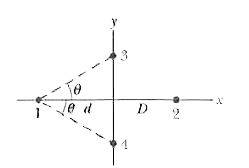
View SolutionIn Fig., particles 1 and 2 have charge 20.0μC each and are held at separation distance d = 0.75 m. (a) What is the magnitude of the electrostatic force on particle 1 due to particle 2? In Fig., particle 3 of charge 20.0μC is positioned so as to complete an equilateral triangle. (b) What is the magnitude of the net electrostatic force on particle 1 due to particles 2 and 3 ?
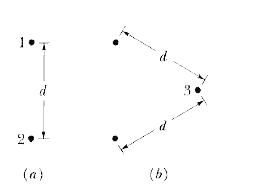
View SolutionIn Fig. a, particle 1 (of charge q1) and particle 2 (of charge q2) are fixed in place on an x axis, 8.00 cm apart.
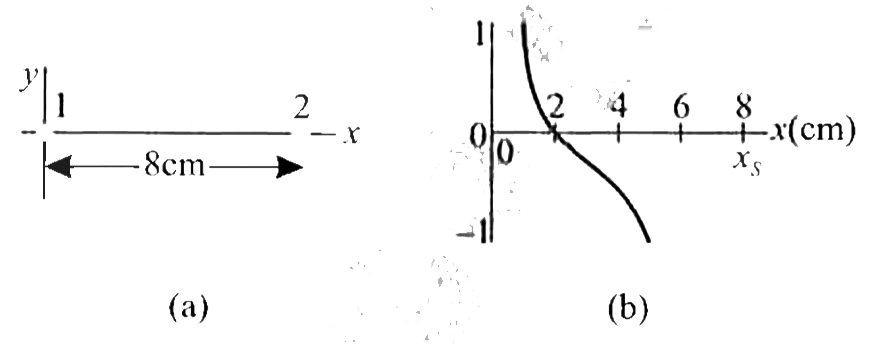
Particle 3 (of charge q3=+8.00×10−19C) is to be placed on the line between particles 1 and 2 so that they produce a net electrostatic force Fnet=2F0 on it Figure b gives the x component of that force versus the coordinate x at which particle 3 is placed. The scale of the x-axis is set by xs=8.0cm. What are (a) the sign of charge q1 and (b) the ratio q2/q1?
View SolutionIn Fig. a, particle 1 (of charge q1) and particle 2 (of charge q2) are fixed in place on an x axis, 8.00 cm apart.

Particle 3 (of charge q3=+8.00×10−19C) is to be placed on the line between particles 1 and 2 so that they produce a net electrostatic force Fnet=2F0 on it Figure b gives the x component of that force versus the coordinate x at which particle 3 is placed. The scale of the x-axis is set by xs=8.0cm. What are (a) the sign of charge q1 and (b) the ratio q2/q1?
View SolutionThe charges and coordinates of two charged particles held fixed in an xy plane are q1=+3.0μC,x1=3.5cm,y1=0.50cm, and q2=−4.0μC,x2=−2.0cm,y2=1.5cm. Find the (a) magnitude and (b) direction of the electrostatic force on particle 1 due to particle 2. At what (c ) x and (d) y coordinates should a third particle of charge q3=+6.0μC be placed such that the net electrostatic force on particle 1 due to particles 2 and 3 is zero ?
View SolutionIn Fig., the four particles fixed in palce and have charges q1=q2=+5e,q3=+3e and q4=−1e. Distance d=8.0μm. What is the magnitude of the net electric field at point P due to the particles ?
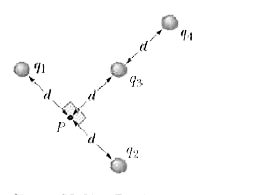
View SolutionIn Fig., particles 1 and 2 are fixed in place on an axis, at a separation of L = 6.00 cm. Their charges are q1=+e and q2=−27e. Particle 3 with charge q3=+4e is to be placed on the line between particles 1 and 2 , so that they produce a net electrostatic force →F3,net on it. (a) At what coordinate should particle 3 be placed to minimize the magnitude of that force ? (b) What is that minimum magnitude ?
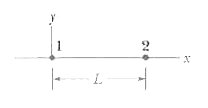
View SolutionIn Fig., particles 2 and 4, of charge -e are fixed in place on a y axis, at y2=−10.0cm and y4=5.00cm. Particles 1 and 3, of charge -e can be moved along the x axis. Particle 5, of charge +e, is fixed at the origin. Initially particle 1 is at x1=−10.0cm and particle 3 is at x3=10.0cm (a) To what x value must particle 1 be moved to rotate the direction of the net electric force →Fnet on particle 5 by 60∘ counterclockwise? (b) With particle 1 fixed at its new position, to what x value must you move particle 3 to rotate →Fnet back to its original direction ?
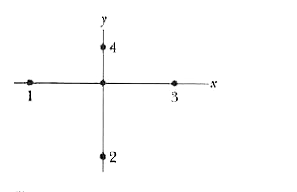
View Solution
